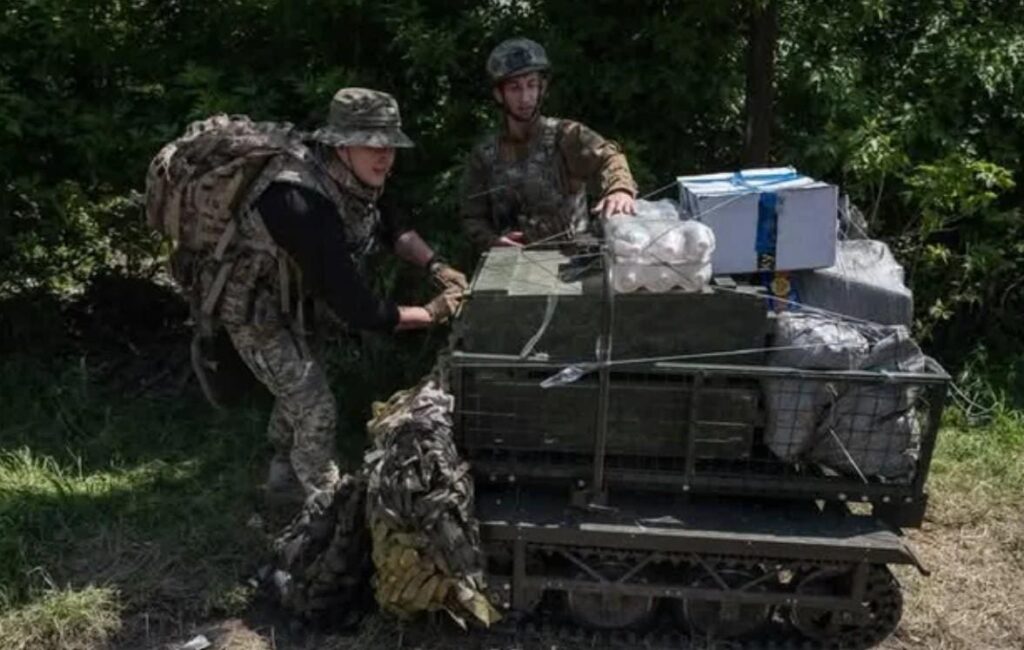Image posted to social media on May 26, 2025 of Ukrainian soldiers from the 93rd Separate Mechanized … More
As the war between Russia and Ukraine continues, both sides are facing the same challenges with resupply. The supply lines are long since soldiers are rapidly expending resources at various locations stretched out across the 600-mile front. As the resupply convoys approach the forward locations, they are frequently targeted and destroyed by enemy drones. Similar to other challenges in the war, both sides are adapting new tactics and technologies to address this issue. In this case, they are both turning to ground robots to deliver resupply.
The use of ground robots for resupply makes practical sense, especially given the manpower shortages of both countries. Instead of using soldiers to run resupply convoys, the soldiers can be allocated towards more direct combat roles. Meanwhile, if enemy drones destroy a ground robot, they only lose a relatively inexpensive system that can be easily repaired or replaced.
Social media post from UkraineWarVideoReport on Reddit showing Ukrainian FPV drones destroy Russian … More
Further, these resupply robots are able to leverage the advances in robotics and autonomy that both countries have honed from their ongoing battle for aerial drone supremacy. The algorithms are somewhat less complicated, since ground robots only move in two dimensions and can be programmed to follow a network of roads to a specific location. These systems can rely on basic sensors to stay on the road and use distance traveled to determine when to turn, reducing the need for external signals that can be jammed, a key feature on this battlefield.
Russian Ground Robots
Russia initially led in deploying ground robots for resupply, driven by Ukraine’s extensive use of aerial drones and Russia’s own high rate of equipment losses. One of the newest Russian platforms is the Volchanin, under development by the Volsk Military Logistics Institute for resupply and casualty evacuation. Russia has also been using the Courier, which was designed to carry a large payload allowing for both combat and logistics roles. Russia has a number of other wheeled and tracked robotic platforms in their arsenal as well.
A social media post showing Russian soldiers loading a four-wheel drive robotic platform with items … More
A social media post from December 2023 shows Russian troops training on resupply with fairly simple wheeled robots. In the video, soldiers load the four-wheeled robot with supplies, which are transported across the battlefield to a waiting soldier, who unloads them and places a casualty onto the robot. Another post from last year shows a tracked robot loaded with resupply being targeted by Ukrainian drones in the Donetsk Oblast. Last month, Ukrainian forces released a compilation of videos on social media of Russian resupply robots, operating around Chasiv Yar. These ground robots are of various types, including both tracked and wheeled, with one featuring an anti-drone cage. These robots are noticeably larger and moving faster than the ones in the earlier videos, indicating more sophisticated systems.
Ukrainian Ground Robots
Similarly, Ukraine has a number of ground robots in its arsenal, including the domestically, produced Sirko-S1 and Volia-E, both of which entered service last summer. The payloads for these ground robots are each around 150-200 kg, such that they can be used for casualty evacuation as well. Ukraine has also received a number of ground robots in foreign aid packages, including the German Gereon RCS vehicles, Estonian THeMIS robot, and the Czech Trail-Blazer.
Social media post on X.com from UkrInform stating, “The ground robot ‘Targan’ has been approved for … More
Recently, Ukraine began deploying the Targan robotic system, which is specifically designed to support frontline logistics. Developed by Ukrainian engineers under the Brave1 Initiative, the Targan was approved by the Ministry of Defense in late 2024. It uses a silent electric motor and large rubber wheels to carry up to 200 kg across rough terrain. There are multiple versions of the Targan in service, with the baseline model having a range of 20 km.
These ground robots have become a regular presence along the front. A recent Ukrainian social media post included images of ground robots being loaded with resupply by the 93rd Mechanized Brigade, which is operating around Pokrovsk. Meanwhile, a recent Russian social media post shows two Ukrainian resupply robots moving at a fast speed through Chasiv Yar, prior to them being targeted by a Russian drone. The Ukrainians seem to be particularly being used in urban areas, where resupply is especially challenging.
Future Trends For Ground Robots
Both Russia and Ukraine will likely increase their usage of ground robots for logistical operations, especially as they face increasing manpower shortages. Similar to their aerial counterparts, future iterations will likely become faster, stronger, and more autonomous over time. They will also likely move into other warfighting domains, especially for casualty evacuation, which many of these drones are already equipped for.
Although both countries have showcased armed versions of these robots, their usage in direct combat roles will likely be limited. On the Russia-Ukraine battlefield, all systems have to be able to operate with their signals degraded by electronic warfare equipment. While resupply can be done with only limited user interactions and limited control system, shooting requires a direct user feed, which is susceptible to jamming.
The use of robots has become a defining characteristic of the Russia-Ukraine war. While ground robots may not achieve the same notoriety as their aerial counterparts, their role is equally important. If the soldiers do not get resupplied, they cannot hold their positions. Their current usage is shaping the current front lines, and their role will likely increase as the war continues.
Read the full article here
